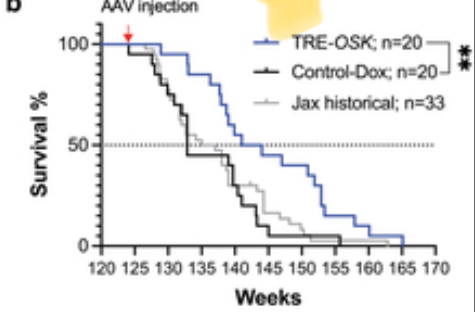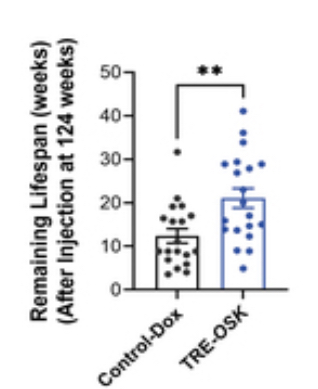In my view this is very exciting, but early. The potential of partial reprogramming - if made to a safe therapy for humans could be truly massive. And it could potentially be done several times during a human’s lifespans.
Rapa, Acar, SGLTi, etc can hopefully get us to a future where partial reprogramming, meaningful CRISPR and replacement therapies could give us many extra decades of healthy, amazing life.
This is a good summary of how I feel about it the study:
These observations, along with recent advances in vector development and optimization, tissue-specific promoters, and inducible systems (Domenger and Grimm, 2019; Li and Samulski, 2020), engender cautious optimism that a partial rejuvenation therapy can be safely delivered in humans.
Because this
A.
To our knowledge, we have shown for the first time an extension of remaining median lifespan in extremely old WT C57BL6/J mice concomitantly with improved health outcomes as a consequence of a systemic AAV-based partial reprogramming therapy.
and
B.
We did not notice any gross teratoma formation when we processed the tissues from animals receiving AAV9-EF1a-rtTA4 ; TRE-OSK or AAV9-CMV-OSK , or during the frailty score measurement
And I like their ambitious, audacious attitude:
Based on our novel proof-of-concept studies in an extremely aged mouse population (equivalent to >80 years of age in humans) and previous studies in younger mice (Browder et al., 2022; Lu et al., 2020; Ocampo et al., 2016), we envision therapeutic rejuvenation in aged humans, first in a specific age-related disease setting and later for therapeutic healthspan and lifespan extension.
Here are the numbers if anyone wants to do the math @RapAdmin suggested - just note that since they started so very late in life, one cannot really compare to ITP type of studies. That would not be apples to apples (either) since the ITP mice even in their subset of “late life”studies were treated much earlier/longer than in the OSK study here
(to compare with rapa/acar, etc, one would have to either do a new rapa/acar, etc study extremely late in life of the mice - or do the partial reprogramming study with start earlier in life (and then perhaps give additional subsequent cycles during the mice’s lives).
control mice had a median lifespan of ∼133 weeks, whereas the TRE-OSK mice had a median lifespan of 142.5 weeks (Fig. 1b, c and Supplementary Fig. S1): a remarkable 109% extension in median remaining life in response to OSK expression (control mice had 8.86 weeks of life remaining vs. 18.5 weeks for TRE-OSK mice).
Graphically here is the key the data

